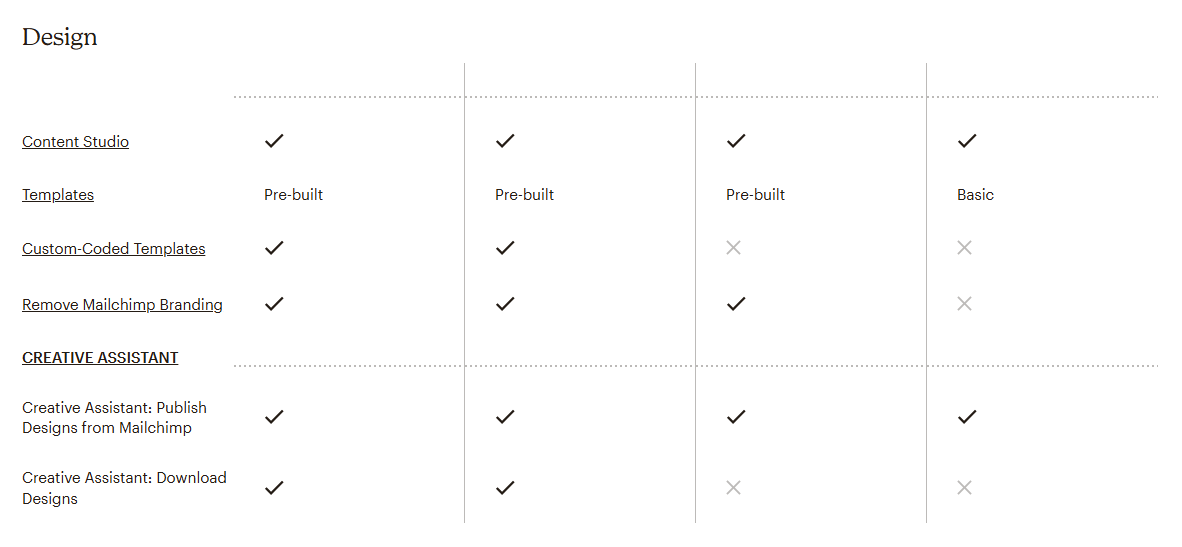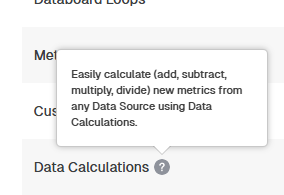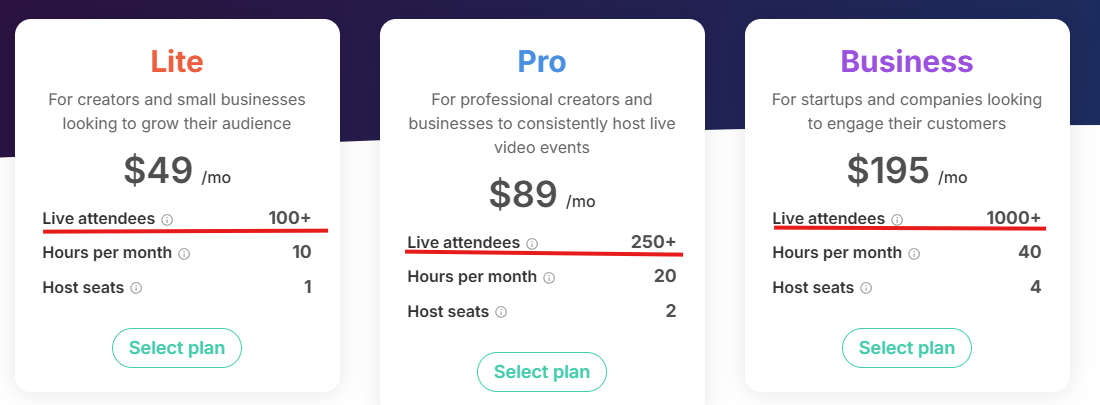Modeling good practices
Use defensive pricing techniques
When it comes to modelling in Pricing2Yaml you are going to have several NUMERIC
usage limits linked to BOOLEAN features. You should be carefull when setting
their defaultValue as it can affect the feature evaluation.
- A feature is considered enabled if its
defaultValueistrue - A feature is disabled if its
defaultValueisfalse - An usage limit is enabled if its
defaultValueis greater than0 - An usage limit is disabled if its
defaultValueis0
TLDR:
- If a usage limit is linked to only one feature both should be enabled or disabled.
- An usage limit linked to multiple feature does not follow this rule.
Example
Good practice:
features:
featureA:
valueType: BOOLEAN
defaultValue: false
featureB:
valueType: BOOLEAN
defaultValue: true
usageLimits:
featureALimit:
valueType: NUMERIC
defaultValue: 0
linkedFeatures:
- featureA
featureBLimit:
valueType: NUMERIC
defaultValue: 30
linkedFeatures:
- featureB
Bad practice:
features:
featureA:
valueType: BOOLEAN
defaultValue: false
featureB:
valueType: BOOLEAN
defaultValue: true
usageLimits:
featureALimit:
valueType: NUMERIC
defaultValue: 30
linkedFeatures:
- featureA
featureBLimit:
valueType: NUMERIC
defaultValue: 0
linkedFeatures:
- featureB
When it comes to modelling the following inconsistencies can happen:
- A feature is enabled and its linked usage limit is disabled
- A feature is disabled and its linked usage limit is disabled
Feature is enabled and usage limit is disabled
features:
featureA:
valueType: BOOLEAN
defaultValue: true
usageLimits:
featureALimit:
valueType: NUMERIC
defaultValue: 0
linkedFeatures:
- featureA
Feature is disabled and usage limit is enabled
features:
featureB:
valueType: BOOLEAN
defaultValue: false
usageLimits:
featureBLimit:
valueType: NUMERIC
defaultValue: 30
linkedFeatures:
- featureB
A story about bad modelling
The business ACME has a SaaS and they are planning to release an extra feature that enable users to store files in the cloud. They have stablished the following usage restrictions:
| Free | Professional | Enterprise | |
|---|---|---|---|
| Data Storage | Not Included | 50 GB | 200 GB |
ACME is using Pricing2Yaml to model his pricing and they have included the file storage
feature like the following:
features:
# other features
fileStorage:
description: Keep your files securely stored, up to date, and accessible across devices
valueType: BOOLEAN
defaultValue: false
expression: userContext['currStorage'] < planContext['usageLimits']['dataStorageLimit']
usageLimits:
fileStorageLimit:
valueType: NUMERIC
defaultValue: 50
unit: GB
linkedFeatures:
- fileStorage
plans:
FREE:
features: null
usageLimits: null
PROFESSIONAL:
features:
fileStorage:
value: true
usageLimits: null
ENTERPRISE:
features:
fileStorage:
value: true
usageLimits:
fileStorageLimit:
value: 200
As explained in the Pricing2Yaml syntax section
all plans will inherit global features and usage limits defaultValue resulting in the
following interpreted values when parsing the config file:
| Free | Professional | Enterprise | |
|---|---|---|---|
fileStorage | false | true | true |
fileStorageLimit | 50 | 50 | 200 |
The feature looks promissing and ACME decides to ship the feature. Months later, they decide to enable file storage feature to FREE users after doing some analysis on their data.
The developer in charge of mantaining the configuration file enables the file storge feature globally, but forgets to update global file storage limit.
Here is the config file with the modification:
features:
fileStorage:
description: Keep your files securely stored, up to date, and accessible across devices
valueType: BOOLEAN
defaultValue: true
expression: userContext['currStorage'] < planContext['usageLimits']['dataStorageLimit']
usageLimits:
fileStorageLimit:
valueType: NUMERIC
defaultValue: 50
unit: GB
linkedFeatures:
- fileStorage
plans:
FREE:
features: null
usageLimits: null
PROFESSIONAL:
usageLimits: null
ENTERPRISE:
usageLimits:
fileStorageLimit:
value: 200
Plans will inherit the following values from the configuration file:
| Free | Professional | Enterprise | |
|---|---|---|---|
fileStorage | true | true | true |
fileStorageLimit | 50 | 50 | 200 |
A week later the development team finds out that FREE users were storing an unusual
amount of files and servers run out of disk space quickly. They tracked
what went wrong and discover that fileStorageLimit was too high, so they change
it accordinly.
features:
fileStorage:
description: Keep your files securely stored, up to date, and accessible across devices
valueType: BOOLEAN
defaultValue: true
expression: userContext['currStorage'] < planContext['usageLimits']['dataStorageLimit']
usageLimits:
fileStorageLimit:
valueType: NUMERIC
defaultValue: 5
unit: GB
linkedFeatures:
- fileStorage
plans:
FREE:
features: null
usageLimits: null
PROFESSIONAL:
usageLimits:
fileStorageLimit:
value: 50
ENTERPRISE:
usageLimits:
fileStorageLimit:
value: 200
Plans will inherit the following values from the configuration file:
| Free | Professional | Enterprise | |
|---|---|---|---|
fileStorage | true | true | true |
fileStorageLimit | 5 | 50 | 200 |
If they originally modeled the pricing with an usage limit of 0 GB, FREE
users would not be able to store any file after enabling fileStorage globally
and servers would not run out of space:
features:
# other features
fileStorage:
description: Keep your files securely stored, up to date, and accessible across devices
valueType: BOOLEAN
defaultValue: false
expression: userContext['currStorage'] < planContext['usageLimits']['dataStorageLimit']
usageLimits:
fileStorageLimit:
valueType: NUMERIC
defaultValue: 0
unit: GB
linkedFeatures:
- fileStorage
plans:
FREE:
features: null
usageLimits: null
PROFESSIONAL:
features:
fileStorage:
value: true
usageLimits:
fileStorageLimit:
value: 50
ENTERPRISE:
features:
fileStorage:
value: true
usageLimits:
fileStorageLimit:
value: 200
Tag your features
If your pricing has a lot of features your potential users might have trouble to mentally process them all at once. This could lead the user to leave your page and choose another competitor due to the lack of structure of the pricing.
To information saturatin group related features with tags. Your users will see the features
grouped by chunks small amounts, making the pricing easier to recall.
This technique is known in psychology as chunking.
Here are some SaaS providers using this technique:



Example
Good practice:
syntaxVersion: '2.1'
saasName: Databox
url: https://web.archive.org/web/20250304080336/https://databox.com/pricing
tags:
- Data Collection
- Connect any Data Source
- Account management & security
features:
dataSources:
tag: Data Collection
dataSyncFrequency:
tag: Data Collection
historicalData:
tag: Data Collection
warehouseDataStorage:
tag: Data Collection
databoxIntegrations:
tag: Connect any Data Source
thirdPartyIntegrations:
tag: Connect any Data Source
integrationType: MARKETPLACE
pushCustomDataToAPI:
tag: Connect any Data Source
customApiIntegrations:
tag: Connect any Data Source
sqlIntegrations:
tag: Connect any Data Source
spreadsheetsIntegration:
tag: Connect any Data Source
userManagement:
type: Account management & security
twoFactorAuthentication:
tag: Account management & security
singleSignOn:
tag: Account management & security
advancedSecurityManagement:
tag: Account management & security
Bad practice
syntaxVersion: '2.1'
saasName: Databox
url: https://web.archive.org/web/20250304080336/https://databox.com/pricing
features:
dataSources:
dataSyncFrequency:
historicalData:
warehouseDataStorage:
databoxIntegrations:
thirdPartyIntegrations:
pushCustomDataToAPI:
customApiIntegrations:
sqlIntegrations:
spreadsheetsIntegration:
userManagement:
twoFactorAuthentication:
singleSignOn:
advancedSecurityManagement:
## ..
Use usage limits naming conventions
It is a good habit to name usage limits including part of the feature name that is linked, for example:
<featureName>Limit<featureName>Uses<featureName>Cap
Example
Good practice:
features:
workspaces:
valueType: BOOLEAN
defaultValue: true
usageLimits:
workspacesLimit:
description: The number of workspaces you can use.
valueType: NUMERIC
defaultValue: 1
unit: workspace
type: NON_RENEWABLE
linkedFeatures:
- workspaces
Bad practice:
features:
workspaces:
valueType: BOOLEAN
defaultValue: true
usageLimits:
usageLimitWk:
description: The number of workspaces you can use.
valueType: NUMERIC
defaultValue: 1
unit: workspace
type: NON_RENEWABLE
linkedFeatures:
- workspaces
Provide descriptions
When modeling features, we tend to reduce the length of the name by identifying it with a few keywords. However, understanding the functionality only looking at the name can be a difficult task and subject to interpretation.
In cases where further context is greatly appreciated, write a brief summary of
the description in the description field. That way, users will be able to
understand your feature even better. As always, decide when it is
necessary to provide a little more context.
Example
Here is an example extracted from Databox:

Good practice:
features:
dataCalculations:
description: |
Easily calculate (add, subtract, multiply, divide) new metrics
from any Data Source using Data Calculations.
valueType: BOOLEAN
defaultValue: true
type: DOMAIN
Bad practice:
features:
dataCalculations:
# What calculation are performed?
valueType: BOOLEAN
defaultValue: true
type: DOMAIN
Avoid using TEXT valueType
In 99.9% of total cases a pricing can be modeled with BOOLEAN features
and NUMERIC usage limits, but when BOOLEAN and NUMERIC valueType
are not enough you can use TEXT as a last resource. You should use BOOLEAN
and NUMERIC as much as possible.
Example
Take a look at Search engine indexing (SEO) feature in Notion pricing:

You could be tempted to model this as a TEXT feature, but there is another option that uses
BOOLEAN features. In this case we can model this feature as two BOOLEAN features,
basicSearchEngineIndexing and advancedSearchEngineIndexing. basicSearchEngineIndexing is
available for all plans and advancedSearchEngineIndexing is only available for Plus, Business and
Enterprise plans.
Good practice:
features:
basicSearchEngineIndexing:
valueType: BOOLEAN
defaultValue: true
advancedSearchEngineIndexing:
valueType: BOOLEAN
defaultValue: false
plans:
FREE:
features: null
PLUS:
features:
advancedSearchEngineIndexing:
value: true
BUSINESS:
features:
advancedSearchEngineIndexing:
value: true
ENTERPRISE:
features:
advancedSearchEngineIndexing:
value: true
Bad practice
features:
searchEngineIndexing:
valueType: TEXT
defaultValue: Basic
plans:
FREE:
features: null
PLUS:
features:
advancedSearchEngineIndexing:
value: Advanced
BUSINESS:
features:
advancedSearchEngineIndexing:
value: Advanced
ENTERPRISE:
features:
advancedSearchEngineIndexing:
value: Advanced
Avoid modelling trials
You might be tempted to model trial features or demos but in reality those features are not granting users permanent access. In practice if a feature is available for trial or a preview of it, that feature should not be enabled for that particular plan.
Example from Notion pricing:

Example
Example from Mailchimp:

Good practice:
Customer Journey Builder has a free preview for Free plan, that feature is false by default even if the pricing offers a preview.
features:
customerJourneyBuilder:
valueType: BOOLEAN
defaultValue: false
plans:
FREE:
features: null
ESSENTIALS:
features:
customerJourneyBuilder:
value: true
STANDARD:
features:
customerJourneyBuilder:
value: true
PREMIUM:
features:
customerJourneyBuilder:
value: true
Bad practice:
Here security alerts is enabled for all plans permanently, but we only want FREE users to use it temporarily. Disabling that feature is highly recommended.
features:
customerJourneyBuilder:
valueType: BOOLEAN
defaultValue: true
plans:
FREE:
features: null
ESSENTIALS:
features: null
STANDARD:
features: null
PREMIUM:
features: null
Avoid modelling recommended usage limits
Saas providers instead of restricting a feature for a particular plan, they make a suggestion for the ideal usage limit. These recommended users limit must not be modeled since there is no restriction for that feature.
Example extracted from Crowdcast pricing:

Example
| Free | Professional | Enterprise | |
|---|---|---|---|
| Online text editor experience | Ideal for 1-3 concurrent users | Ideal for 5+ concurrent users | Ideal for 15+ concurrent users |
Good practice:
features:
onlineTextEditor:
valueType: BOOLEAN
defaultValue: true
plans:
FREE:
PROFESSIONAL:
ENTERPRISE:
# .. Not modeled recommended usage limits present
Bad practice:
You should not model recommended usage limits
features:
onlineTextEditor:
valueType: BOOLEAN
defaultValue: true
usageLimits:
onlineTextEditorConcurrentUsersPreference:
valueType: TEXT
defaultValue: Ideal for 1-3 concurrent users
linkedFeatures:
- onlineTextEditor
plans:
FREE:
PROFESSIONAL:
usageLimits:
onlineTextEditorConcurrentUsersPreference:
value: Ideal for 5+ concurrent users
ENTERPRISE:
usageLimits:
value: Ideal for 15+ concurrent users